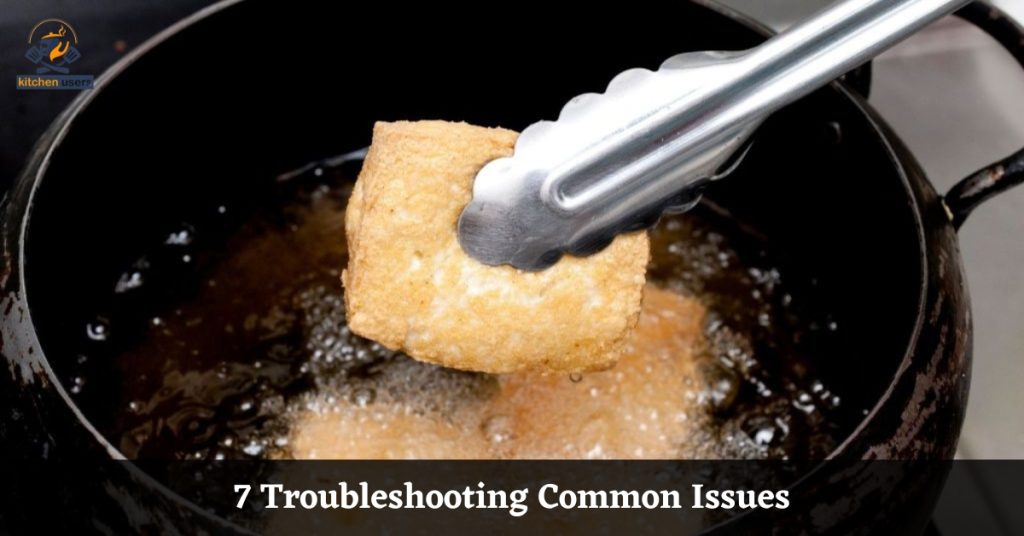Choosing The Right Oil For Frying is super important for tasty and healthy meals. Each oil has its own special flavor and texture that can make food delicious. Smoke points are also essential to know because they tell us the safe temperature for cooking with different oils.Some oils are best for high-heat cooking like frying, while others are better for gentle cooking.
It’s important to consider the ways oils can be good for our health. Some are good for our hearts, while others have too much-saturated fat and should be used less. Understanding cooking oils helps us make yummy and nutritious meals. This guide will show you all about cooking oils and how to use them smartly in your cooking adventures! Get ready to be a great cook!
Factors to Consider

Smoke Point and Frying Methods
When picking cooking oils, think about their smoke points, especially for frying. Oils with high smoke points, like canola or peanut oil, are great for deep-frying and stir-frying because they don’t burn easily. Use oils with lower smoke points, like olive oil, for light cooking. Using the right oil for each method makes your food taste delicious.
Flavor Profile and Pairing Options
Cooking oils have different flavors that can affect your dishes. Some, like sesame oil, have strong tastes, perfect for certain recipes. Others, like vegetable oil, have a mild flavor that works well with many foods. Consider the oil’s taste and how it goes with the ingredients in your recipe.
Nutritional Content and Healthier Choices
Thinking about nutrition is important for healthy cooking. Oils with good fats, like olive or avocado oil, are good for your heart and overall health. Oils with too much-saturated fat, like coconut oil, should be used less.
Allergies and Dietary Restrictions
Be careful with allergies and diets when choosing oils. Some people might be allergic to certain nuts or seeds, so avoid oils from those ingredients. If you have a special diet, like being vegan or gluten-free, choose oils that are suitable for your diet. We have discussed Types Of Fryers in another post.
Considering these factors will help you cook better and make healthier choices. Happy cooking!
Types of Frying Techniques
Shallow Frying
Shallow frying is a cooking technique where food is partially submerged in oil and cooked on one side. It’s perfect for foods like pancakes, eggs, or chicken cutlets. In shallow frying, the oil level is low, and the food is flipped to cook evenly on both sides. It’s a quick and easy way to get a crispy texture and delicious taste without using too much oil.
Deep Frying
Deep frying means putting the food completely in hot oil. It’s commonly used for preparing crispy treats like french fries, chicken wings, or donuts. Deep frying requires more oil, and the food cooks quickly due to the high temperature. To avoid excess oil absorption, the food should be properly drained on a paper towel after frying.
Stir-Frying
Stir-frying is a popular Asian cooking technique where small pieces of food are quickly cooked in a hot pan with a small amount of oil. The food is continuously stirred to cook evenly and prevent burning. Stir-frying is great for vegetables, meat, and tofu, and it retains the natural flavors and textures of the ingredients.
Each frying technique offers a different way to cook and enjoy tasty dishes. Shallow frying for light crispiness, deep frying for indulgent treats, and stir-frying for quick and healthy meals. By mastering these techniques, you’ll become a skilled chef, ready to create a variety of delicious fried dishes. Happy frying!
Health Considerations

Impact on Oil Stability and Nutrition
Health is important, so we need to think about how cooking oil affects us. Some oils can change when they get hot and become less healthy. Oils with high smoke points, like canola or sunflower oil, are better for cooking at high temperatures because they stay more stable. Also, different oils have different nutrients. Some, like olive oil and avocado oil, are good for our hearts because they have healthy fats. Others, like coconut oil, have too much-saturated fat, so we should use them less.
Moderation and Alternatives
Using a lot of oil in our cooking is not good for our bodies. We should try to use less oil and find other ways to cook. Instead of frying, we can bake, steam, or grill our food. We can also use a little bit of oil or try using vegetable or chicken broth for sautéing. Cooking sprays are also a good option. By being careful with the amount of oil we use and trying other cooking methods, we can stay healthy and enjoy our meals.
Being mindful of health considerations when using cooking oil helps us make smart choices for our well-being. Think about oil stability and nutrition, choosing oils with higher smoke points and better fats. Use oil in moderation and explore different cooking methods for healthier and tasty meals. With these tips, we can have a happy and healthy kitchen experience!
7 Tips for Extending Oil Lifespan
Taking care of cooking oil is important to make it last longer and stay fresh. Here are some helpful tips for extending the lifespan of your oil:
1. Store in a Cool and Dark Place:
Keep your oil in a cool and dark cupboard or pantry away from direct sunlight and heat. Light and warmth can make the oil spoil faster.
2. Use Clean and Dry Utensils:
When using oil, make sure your utensils, such as spoons or tongs, are clean and dry. Water or food particles in the oil can lead to spoilage.
3. Keep the Lid Closed:
Always close the oil bottle tightly after use. Oxygen can cause the oil to go rancid, so keeping it airtight is essential.
4. Avoid Mixing Different Oils:
It’s best not to mix different types of oils in the same container as they may have different flavors and properties, affecting each other.
5. Filter and Strain Used Oil:
If you reuse oil, strain it through a fine mesh or cheesecloth to remove any food particles and debris. This helps to keep the oil clean for later use.
6. Check for Off Odors and Flavors:
Before using the oil, smell and taste it to ensure it hasn’t gone bad. If it smells rancid or has an unpleasant taste, it’s time to discard it.
7. Observe the Expiration Date:
Cooking oils have an expiration date, so check the label to make sure you use them before they go bad.
By following these tips, you can make the most of your cooking oil and enjoy fresh and delicious meals every time you cook. Taking care of your oil ensures that your dishes will taste great and be healthier too!
7 Troubleshooting Common Issues

Cooking can be fun, but sometimes we face challenges in the kitchen. Here are some common issues and how to solve them:
1. Food Sticking to the Pan:
If your food is sticking to the pan, it’s probably because the pan isn’t properly heated or the surface isn’t well-greased. To prevent sticking, preheat the pan before adding the food and use enough oil or cooking spray.
2. Uneven Cooking:
Uneven cooking can happen when the heat isn’t distributed evenly. Make sure your stovetop or oven is set to the right temperature, and use the right size pan for your ingredients.
3. Overcooking or Undercooking:
Timing is crucial in cooking. Use a timer or set an alarm to avoid overcooking or undercooking your dishes. Follow recipes and cooking instructions carefully.
4. Bland or Overly Salty Food:
Getting the right balance of flavors is important. If your food is bland, try adding more seasoning or herbs. If it’s too salty, add a bit of lemon juice or sugar to balance it out.
5. Burnt Food:
Burnt food can happen when the heat is too high or when you leave the food unattended. Lower the heat and keep a close eye on your cooking to prevent burning.
6. Runny or Curdled Sauces:
If your sauce is too runny, you can thicken it with a cornstarch slurry. If it curdles, remove it from heat and whisk vigorously to bring it back together.
7. Dough Difficulties:
If your dough is too dry, add a little water. If it’s too sticky, add a bit more flour. Kneading the dough well can also help achieve the right texture.
Remember, cooking takes practice, and it’s okay to make mistakes. Don’t be afraid to try new things and experiment in the kitchen. With time and patience, you’ll become a better cook and enjoy the delicious meals you’ve prepared yourself!
Conclusion
In this cooking guide, we’ve learned important aspects of cooking, like picking the right oil and trying different frying techniques. Health considerations and tips for keeping oil fresh help us make better choices. Don’t be afraid to experiment and make mistakes; it’s part of the fun! Cooking is a creative adventure filled with delicious flavors. We have covered Choosing The Right Oil For Frying in this post. So, get ready, put on your apron, and enjoy the exciting journey of cooking. Happy cooking, little chef! Have fun in the kitchen!
As a 10 years veteran in the culinary industry, I have developed a passion for all things kitchen. With a deep understanding of food preparation and cooking techniques, I am a true kitchen specialist. My experience working in Khedmot kitchen has allowed me to hone my skills and become an expert in creating delicious and visually appealing dishes.
I am a creative and innovative chef, constantly experimenting with new ingredients and cooking methods to bring unique and memorable dining experiences to my customers. In addition to my culinary expertise, I am also highly organized and able to effectively manage a team of kitchen staff, ensuring that all tasks are completed efficiently and to a high standard.
I am dedicated to my craft and always strive to create exceptional dining experiences for my customers. Whether it’s developing a new menu, training my kitchen team, or working with local suppliers, I am always looking for ways to improve and take my kitchen to the next level.
If you’re looking for a skilled and passionate kitchen specialist, look no further. I am eager to bring my expertise to your team and help take your kitchen to the next level.


